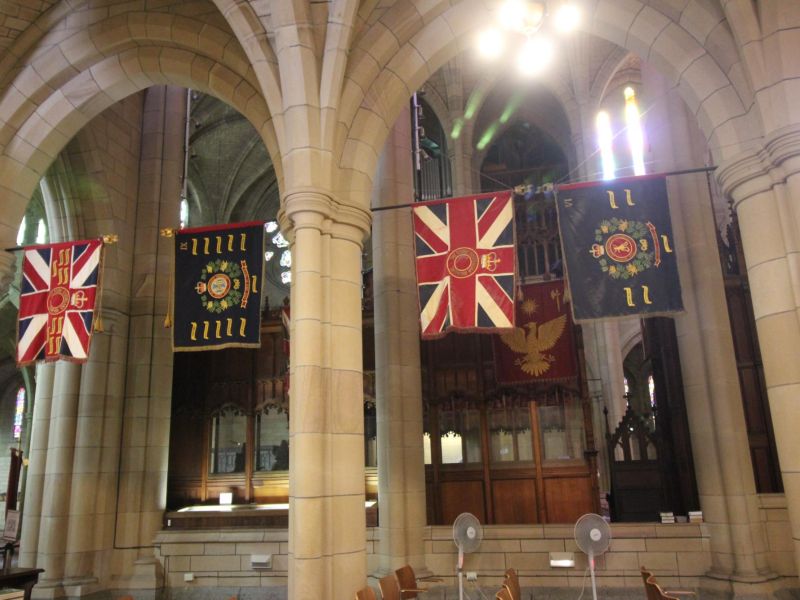Honouring the Fallen in sacred space: the Regimental Colours of St John’s Cathedral, Brisbane
There is a time-honoured tradition that Australian Army units present their regimental banners known as "colours" (in the case of infantry units) and "guidons" (in the case of mounted infantry units) in an appropriate public institution such as a cathedral, whenever there ceremonial standards are superseded by new ones, or the regimental unit is disbanded.
The old colours and guidons are not disposed of but are "laid-up" in the cathedral (or other public space) where they are left to gradually decay or turn to "dust", just as the fallen bodies of the soldiers who served in these units also turn to "dust". The cathedral effectively becomes the "tomb" of the banner.
Since the First World War, many Army colours and guidons have been laid-up in St John's Cathedral in Brisbane and some still hang there.
One Army unit which for many years has laid-up its colours in St John's is the 9th Battalion, Royal Queensland Regiment ("RQR"). The Battalion is Brisbane's oldest light infantry unit, tracing its history back to 1867.
Over the course of its history, the Battalion has served Australia in a number of conflicts, including the Boer War and both World Wars, while more recently it has been involved in peacekeeping operations and exercises around the Pacific region. The most recent colours of the Battalion laid-up in the Cathedral were those issued in 1967 which had been superseded by new ones issued in 2014.
The former colours from 1967 comprise two banners: the "Queen's Colours" and the "Regimental Colours". They were laid-up in St John's on 8 August 2015 in a ceremony rather resembling a funeral. During the service the colours were formally received into the Cathedral by the Governor of Queensland, the Hon. Paul de Jersey AC QC, and the Dean of the Cathedral, the Very Rev'd Dr Peter Catt.
The colours bear the names or "battle honours" of the Battalion's significant engagements dating back to the Boer War in 1899 and the First World War, including the Gallipoli campaign. In 1915 the 9th Battalion had the first man ashore at the Anzac dawn landings at Gallipoli: Lieutenant Duncan Chapman of Maryborough, Queensland.
For all soldiers, past and present, the colours of their military unit are sacred to mission and the lives they honour. The colours which hang in St John's Cathedral speak to the mutual esteem in which they are held by the Australian Defence Force and the wider Brisbane community. They also speak to the linkages between military sacrifice and eternal life, embodied in the faith of the Christian tradition which the Cathedral represents.
Other Queensland-based Army units whose colours or guidons have been laid-up in the Cathedral in past years include the former 5th and 11th Light Horse Regiments disbanded in 1943 (guidons laid-up in 1959); the 15th Infantry Battalion disbanded in 1946 (colours laid-up in 1953); the 2nd/14th Light Horse Regiment (guidons laid-up in 1972); and the 6th Battalion, Royal Australian Regiment (colours last laid-up in 1988).
Denzil Scrivens
- Taken from "St John's Cathedral and the Anzac Legend" by Denzil Scrivens printe… https://www.stjohnscathedral.com.au/discover-st-johns/
 Denzil Scrivens
Denzil Scrivens